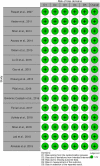Optical Coherence Tomography in Mild Cognitive Impairment: A Systematic Review and Meta-Analysis
- PMID: 33178120
- PMCID: PMC7596384
- DOI: 10.3389/fneur.2020.578698
Optical Coherence Tomography in Mild Cognitive Impairment: A Systematic Review and Meta-Analysis
Abstract
Purpose: The use of optical coherence tomography (OCT) of the retina to detect inner retinal degeneration is being investigated as a potential biomarker for mild cognitive impairment (MCI) and Alzheimer's disease (AD), and an overwhelming body of evidence indicates that discovery of disease-modifying treatments for AD should be aimed at the pre-dementia clinical stage of AD, i.e., MCI. We aimed to perform a systematic review and meta-analysis on retinal OCT in MCI. Methods: We performed a systematic review of the English literature in three databases (PubMed, Embase, and Latindex) for studies that measured retinal thickness using OCT in people with MCI and healthy controls, age 50 or older, between 1 January 2000 and 31 July 2019. Only cohort and case-control studies were reviewed, and independent extraction of quality data and established objective data was performed. We calculated the effect size for studies in the review that met the following criteria: (1) a statistically significant difference between MCI subjects and normal controls for several OCT variables, (2) use of spectral domain OCT, and (3) use of APOSTEL recommendations for OCT reporting. Weighted Hedges' g statistic was used to calculate the pooled effect size for four variables: ganglion cell layer-inner plexiform layer (GCL-IPL) complex thickness in micrometers (μm), circumpapillary retinal nerve fiber layer (pRNFL) thickness in μm, macular thickness in μm, and macular volume in μm3. For variables with high heterogeneity, a multivariate meta-regression was performed. We followed the PRISMA guidelines for systematic reviews. Results: Fifteen articles met the inclusion criteria. A total of 58.9% of MCI patients had statistically significant thinning of the pRNFL compared with normal subjects, while 61.6% of all MCI patients who had macular volume measured had a statistically significant reduction in volume compared with controls, and 50.0% of the macular GCL-IPL complexes measured demonstrated significant thinning in MCI compared with normal controls. Meta-analysis demonstrated a large effect size for decreased macular thickness in MCI subjects compared with normal controls, but there was a substantial heterogeneity for macular thickness results. The other variables did not demonstrate a significant difference and also had substantial heterogeneity. Meta-regression analysis did not reveal an explanation for the heterogeneity. Conclusions: A better understanding of the cause of retina degeneration and longitudinal, standardized studies are needed to determine if optical coherence tomography can be used as a biomarker for mild cognitive impairment due to Alzheimer's disease.
Keywords: Alzheimer's disease; biomarker; meta–analysis; mild cognitive impairment; optical coherence tomography; retina; systematic review.
Copyright © 2020 Mejia-Vergara, Restrepo-Jimenez and Pelak.
Figures






Similar articles
-
Optical coherence tomography in mild cognitive impairment - Systematic review and meta-analysis.Clin Neurol Neurosurg. 2020 Sep;196:106036. doi: 10.1016/j.clineuro.2020.106036. Epub 2020 Jun 22. Clin Neurol Neurosurg. 2020. PMID: 32623211
-
Optical Coherence Tomography Reveals Retinal Neuroaxonal Thinning in Frontotemporal Dementia as in Alzheimer's Disease.J Alzheimers Dis. 2017;56(3):1101-1107. doi: 10.3233/JAD-160886. J Alzheimers Dis. 2017. PMID: 28106555
-
Spectral-Domain OCT Measurements in Alzheimer's Disease: A Systematic Review and Meta-analysis.Ophthalmology. 2019 Apr;126(4):497-510. doi: 10.1016/j.ophtha.2018.08.009. Epub 2018 Aug 13. Ophthalmology. 2019. PMID: 30114417 Free PMC article.
-
Neuro-Retina Might Reflect Alzheimer's Disease Stage.J Alzheimers Dis. 2020;77(4):1455-1468. doi: 10.3233/JAD-200043. J Alzheimers Dis. 2020. PMID: 32925026
-
Retinal ganglion cell analysis using high-definition optical coherence tomography in patients with mild cognitive impairment and Alzheimer's disease.J Alzheimers Dis. 2015;45(1):45-56. doi: 10.3233/JAD-141659. J Alzheimers Dis. 2015. PMID: 25428254
Cited by
-
Changes in retinal multilayer thickness and vascular network of patients with Alzheimer's disease.Biomed Eng Online. 2021 Oct 3;20(1):97. doi: 10.1186/s12938-021-00931-2. Biomed Eng Online. 2021. PMID: 34602087 Free PMC article.
-
Correlation between retinal vessel rarefaction and psychometric measures in an older Southern Italian population.Front Aging Neurosci. 2022 Sep 23;14:999796. doi: 10.3389/fnagi.2022.999796. eCollection 2022. Front Aging Neurosci. 2022. PMID: 36212041 Free PMC article.
-
Using Optical Coherence Tomography to Screen for Cognitive Impairment and Dementia.J Alzheimers Dis. 2021;84(2):723-736. doi: 10.3233/JAD-210328. J Alzheimers Dis. 2021. PMID: 34569948 Free PMC article.
-
Neurodegeneration in the retina of motoneuron diseases: a longitudinal study in amyotrophic lateral sclerosis and Kennedy's disease.J Neurol. 2023 Sep;270(9):4478-4486. doi: 10.1007/s00415-023-11802-2. Epub 2023 Jun 8. J Neurol. 2023. PMID: 37289322 Free PMC article.
-
Association between retinal markers and cognition in older adults: a systematic review.BMJ Open. 2022 Jun 21;12(6):e054657. doi: 10.1136/bmjopen-2021-054657. BMJ Open. 2022. PMID: 35728906 Free PMC article.
References
-
- Marziani E, Pomati S, Ramolfo P, Cigada M, Giani A, Mariani C, et al. . Evaluation of retinal nerve fiber layer and ganglion cell layer thickness in Alzheimer's disease using spectral-domain optical coherence tomography. Invest Ophthalmol Vis Sci. (2013) 54:5953–8. 10.1167/iovs.13-12046 - DOI - PubMed
Publication types
LinkOut - more resources
Full Text Sources
Miscellaneous

